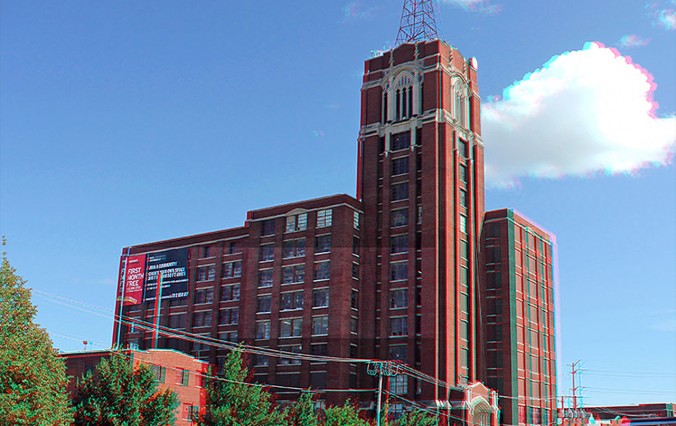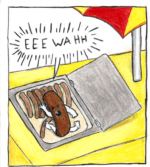A New Community and Complex of Arts Activity in Pilsen
Mana Contemporary opened up its Chicago branch in September 2013, converting an empty auto-parts factory into a hub of activity for a community of emerging and established artists and the wider arts community. Designed by architect George Nimmons in 1926, the imposingly large 14-story landmark building originally served as a warehouse and garage for Commonwealth Edison’s Fisk Generating station, incorporating a 198-foot-high radio tower as the communication system to dispatch emergency equipment. Now the building at 2233 Throop Street is set to become part of a national network of spaces that incorporate artist studios, climate controlled storage, art handling, exhibitions, shared equipment spaces, and areas for performance and programming.
The arts enterprise has its roots as a moving and storage company owned by Moishe Mana. Artist and former Moishe’s Self Storage employee, Eugene Lemay was a co-founder of Mana Fine Arts, and now acts as the company’s curatorial advisor. Micha Lang, the visionary and co-founder of Mana Chicago has also been involved with the business from its early days. For a time Moishe’s was a go-to job market for Israeli artist immigrants to the US and New York City.
The company’s auspicious innovation in the mid-1980s was the development of a barcode method to quickly retrieve medical and legal papers from their document storage units. Locations close to the centers of cities meant that they could act within a couple of hours instead of days. With the advent of digital archiving, access to original documents became less pressing and they were able to store materials at more distant locations. Now these nationally distributed, centrally located urban warehouses are being converted to use for art. The company’s flagship art center is a 1.5-million-sq. ft. Jersey City complex, 15 minutes from the center of New York City via PATH train.
In Chicago, the venture is fairly central to the Pilsen neighborhood, only four blocks away from the main drag of 18th Street. Nick Wylie, artistic director and Pilsen resident for seven years pointed out that despite being ten minutes from the center of town, there is a veil of inaccessibility which may have aided in protecting the area from the rapid gentrification seen in places like Logan Square. That said, he admits that the building can be difficult to find and he provides a paragraph of directions to new visitors that are journeying to the studios, located at the unlikely dead-end of Throop, where it meets the south branch of the Chicago River.
“The Chicago location is just starting out. We’re going to have a lot more activity and keep getting better and better. We’re opening up the second floor next month,” says Chicago manager Micha Lang. A year and a half ago he began scouting Chicago for the next Mana outpost. After meeting Lisa Lee and Matt Siber, he was introduced to even more artists. Nick Wylie, co-director of ACRE (Artist Co-operative Residency & Exhibitions), and Ciara Ruffino, also an administrator of ACRE, are now part of the team at Mana that reaches out to people they think would contribute to the community and invites them to consider a studio.
Artist duo and SAIC alumni Industry of the Ordinary as well as SAIC teachers Jan Tichy, Claire Pentecost, Jason Lazarus all have studios in the building. Pentecost and Lazarus are planning for some of their classes to exhibit work in their studios. Dance company Lucky Plush, who operate under the administrative umbrella of Creative Partners alongside eighth blackbird sextet and Blair Thomas Puppetry, are planning on opening facilities on the 6th floor. The fifth floor hosts 19 artists and the soon to be opened fourth floor will host an additional 27. Artists can also contact Mana Contemporary to inquire about spaces, and though reviewed by committee, there are many young artists and recent graduates in the building. “The average age on the fourth floor space is about 24 or 25,” says Lang. At $1.20/sq. ft. and running at 300-2,000 sq. ft., there are spaces for a variety of budgets.
Mana Contemporary currently operates in 300,000 sq. ft. of the building, and has plans to expand throughout an additional nine floors. The rest of the space is occupied by storage, “which is helpful to artists in the building,” Wylie points out, and small creative businesses. ACRE currently runs a maker space in the building and helps build inexpensive computers for artists. The offices and programming of High Concept Laboratories (HCL) are based there and also facilitate wider programming within the space; next year HCL plans on opening a glassed off performance area and spaces to host 12 annually supported artists. A classroom space from the University of Illinois Chicago soon to be dedicated to 3D printing, a classroom and screening space, and a library donated by Donald Young are located on the 5th floor. The Propeller Fund, a funding body in turn supported by the Andy Warhol Foundation for the Visual Arts to facilitate Chicago artists, is also planning to host two of their former grantees per year in dedicated studio spaces on the fourth floor.
The venue is in conversation with independents to establish digital printing and framing services within one 2,000-sq. ft. area. Two weeks ago the company merged with Terry Dowd, an art handling company that will be establishing major facilities in the building, offering knowledge and professionalism for climate controlled storage and transportation of art and collections, contributing to studio residents’ access to safe international shipping.
Lang’s excitement about the venture was palpable, as he described the creation of a space that is welcoming to artists, collectors, and gallery owners. He said that the Chicago location was even easier to deal with than in Jersey City, perhaps due to Midwestern friendliness. Wylie mentioned that much of Chicago’s art scene circulates around educational establishments, while New York City’s major influence holders are the galleries, which is reflected in the institutional partnering of the respective complexes.
The venue is not only for artists that have studios within the building. Wylie said that the organization plans to establish a wing dedicated to artist services open to all in the Chicago wide community. He hopes that “it can encourage cross-pollination as a multi-institutional meeting point.” The 4,000-sq. ft. area on the ground floor already hosts performances organized by in-house residents, by HCL, and by other interested parties. Wylie said there have been events almost every weekend. SAIC’s 2nd year performance grads ran an event on Friday 28th February. In mid-February HCL hosted a Valentine’s Day dance. HCL is also a helpful mailing list to join to find out about upcoming programming. The University of Wisconsin-Madison curated a show of graduate work in the space as well. Some events, such as the Fluxfest 2014 and Ron Athey’s recent performance, are donated to the space, while fundraisers and universities rent the space. Hospitable, open, and professional, Mana Contemporary is set to be an exciting venue for Chicago’s artists and art-interested folk to participate.
— For more information, please visit Mana Contemporary’s website at www.manacontemporary.com and www.manafinearts.com






















